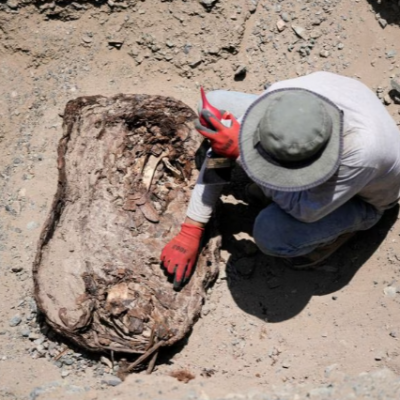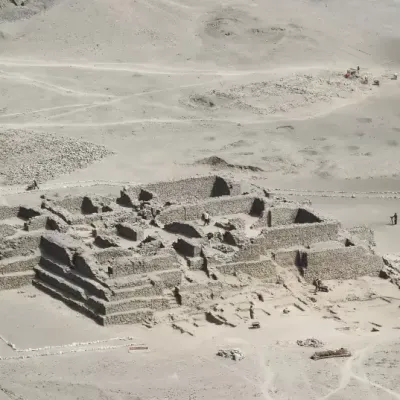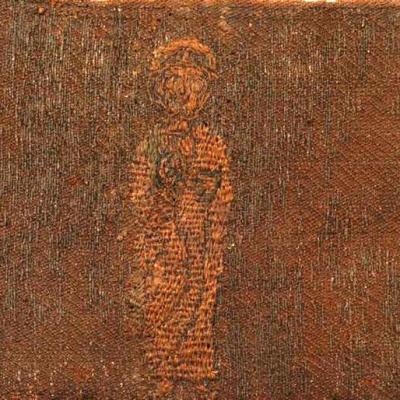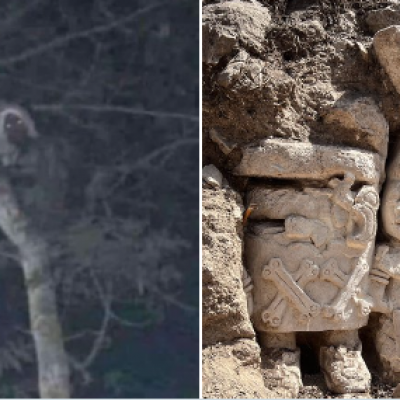INSTITUT SUPERIEUR D'ANTHROPOLOGIE
INSTITUTE OF ANTHROPOLOGY
ONLINE COURSES / COURS A DISTANCE
DEBUT COURS : AVRIL 2023
REGISTER NOW
PEROU – 
 Huaral - Peruvian archaeologists have discovered some 30 pre-Inca era graves in a cemetery belonging to the Chancay people, a group who inhabited valleys of Peru's central coast from 1000 to 1500 AD. The newly found 800-year-old graves have allowed specialists to know more about the Chancay culture, which has been little researched, Pieter Van Dalen, archeologist at San Marcos university, told Reuters. Archaeologists from the University of San Marcos work at the site of a burial belonging to the Chantay pre-Columbian culture, which was found in a cemetery at Macaton mountain in the north-central Huaral valley, in Huaral, Peru. The graves unearthed belong to people from different social classes, according to Van Dalen, who noted some were found at up to five meters (16.4 feet) below the surface and belonged to Chancay's elite.
Huaral - Peruvian archaeologists have discovered some 30 pre-Inca era graves in a cemetery belonging to the Chancay people, a group who inhabited valleys of Peru's central coast from 1000 to 1500 AD. The newly found 800-year-old graves have allowed specialists to know more about the Chancay culture, which has been little researched, Pieter Van Dalen, archeologist at San Marcos university, told Reuters. Archaeologists from the University of San Marcos work at the site of a burial belonging to the Chantay pre-Columbian culture, which was found in a cemetery at Macaton mountain in the north-central Huaral valley, in Huaral, Peru. The graves unearthed belong to people from different social classes, according to Van Dalen, who noted some were found at up to five meters (16.4 feet) below the surface and belonged to Chancay's elite.
VIDEO = https://www.wionews.com/videos/peru-archaeologists-unearth-30-graves-from-pre-inca-age-that-date-back-between-1000-1440-ad-565990
https://www.reuters.com/lifestyle/peruvian-archaeologists-unearth-30-pre-inca-era-graves-2023-02-25/
PEROU –  Pakaytambo - Archaeologists discovered a temple in Peru that was constructed over 1,200 years ago by the Wari Empire, according to a study. According to the peer-reviewed study, which was published earlier this month in the Journal of Anthropological Archaeology, the temple was built on top of a platform with adjoining structures in which religious officials would have lived.The Wari controlled large parts of modern-day Peru using tactics ranging from military force to the expansion of trade routes. Open plaza spaces associated with the temple complex at Pakaytambo would have allowed local communities to participate in ritual gatherings organized by the Wari. Temple complexes of premodern states served critical roles beyond that of a religious function. Both political and economic activities were often embedded within state-sponsored rituals, ceremonies, and events organized by temple institutions. Archaeological investigations at the newly discovered temple center of Pakaytambo provide the first conclusive evidence of an intrusive Wari imperial presence in the Majes-Chuquibamba region of Arequipa
Pakaytambo - Archaeologists discovered a temple in Peru that was constructed over 1,200 years ago by the Wari Empire, according to a study. According to the peer-reviewed study, which was published earlier this month in the Journal of Anthropological Archaeology, the temple was built on top of a platform with adjoining structures in which religious officials would have lived.The Wari controlled large parts of modern-day Peru using tactics ranging from military force to the expansion of trade routes. Open plaza spaces associated with the temple complex at Pakaytambo would have allowed local communities to participate in ritual gatherings organized by the Wari. Temple complexes of premodern states served critical roles beyond that of a religious function. Both political and economic activities were often embedded within state-sponsored rituals, ceremonies, and events organized by temple institutions. Archaeological investigations at the newly discovered temple center of Pakaytambo provide the first conclusive evidence of an intrusive Wari imperial presence in the Majes-Chuquibamba region of Arequipa
https://www.jpost.com/archaeology/article-732738
RUSSIE –  Russian archaeologists have uncovered a rare embroidered Deisis depicting Jesus Christ in a medieval burial ground. 46 graves have been dug up during excavations; one of them contained a woman who was buried with an embroidered Deisis depicting Jesus Christ and John the Baptist and was between the ages of 16 and 25. The discovery was made during the construction of the Moscow-Kazan highway, where archaeologists found an 8.6-acre medieval settlement and an associated Christian cemetery. The iconography of Jesus Christ known as Deesis, which can be translated from Greek as “prayer” or “intercession,” is one of the most potent and prevalent images in Orthodox religious art. The composition of the Deisis unites the three most important figures of Christianity. A tripartite icon of the Eastern Orthodox Church showing Christ usually enthroned between the Virgin Mary and St. John the Baptist. The fabric is 12.1 cm long by 5.5 cm wide and is composed of two parts joined by a vertical seam made of a woven gold ribbon with a braided pattern. The fabric’s lining did not survive, but a microscopic examination revealed birch bark remnants and needle punctures along the lower and upper edges. In the center of the fabric is a frontal image of Jesus Christ making a blessing gesture, and to the right of him is John the Baptist praying. A second figure, probably Mary, was once on the left, but it has since disappeared, according to the inspection. The archaeologists believe the embroidered fabric was once a dark silk samite headdress. Similar examples include the embroidered crosses and faces of saints discovered in the Karoshsky burial ground in the Yaroslavl region, as well as the Ivorovsky necropolis near Staritsa that features an image of Michael the Archangel wielding a spear.
Russian archaeologists have uncovered a rare embroidered Deisis depicting Jesus Christ in a medieval burial ground. 46 graves have been dug up during excavations; one of them contained a woman who was buried with an embroidered Deisis depicting Jesus Christ and John the Baptist and was between the ages of 16 and 25. The discovery was made during the construction of the Moscow-Kazan highway, where archaeologists found an 8.6-acre medieval settlement and an associated Christian cemetery. The iconography of Jesus Christ known as Deesis, which can be translated from Greek as “prayer” or “intercession,” is one of the most potent and prevalent images in Orthodox religious art. The composition of the Deisis unites the three most important figures of Christianity. A tripartite icon of the Eastern Orthodox Church showing Christ usually enthroned between the Virgin Mary and St. John the Baptist. The fabric is 12.1 cm long by 5.5 cm wide and is composed of two parts joined by a vertical seam made of a woven gold ribbon with a braided pattern. The fabric’s lining did not survive, but a microscopic examination revealed birch bark remnants and needle punctures along the lower and upper edges. In the center of the fabric is a frontal image of Jesus Christ making a blessing gesture, and to the right of him is John the Baptist praying. A second figure, probably Mary, was once on the left, but it has since disappeared, according to the inspection. The archaeologists believe the embroidered fabric was once a dark silk samite headdress. Similar examples include the embroidered crosses and faces of saints discovered in the Karoshsky burial ground in the Yaroslavl region, as well as the Ivorovsky necropolis near Staritsa that features an image of Michael the Archangel wielding a spear.
https://arkeonews.net/in-medieval-burial-ground-a-rare-embroidered-deisis-depicting-jesus-christ-was-discovered/
CHINE - Shangjing - Archaeologists have discovered the ruins of a large building foundation in an imperial city dating back to the Liao Dynasty (916-1125) in North China's Inner Mongolia autonomous region. The building relics were found in late 2022 in a courtyard of the imperial city in the ruins of Shangjing, the ancient capital of the Liao Dynasty, according to the region's institute of cultural relics and archaeology. The Shangjing site, which was divided into two parts, including an imperial city, is located in Lindong township of Baarin Left Banner, Inner Mongolia. An array of artifacts including building components, ceramics, clay sculptures, and copper coins, have also been unearthed. The nomadic Khitan founded the Liao Dynasty. Archaeologists say the Khitan people believed the east is where the sun rises and can bring auspiciousness and light, so the imperial city and palaces faced east. The discovery of the large south-facing building has deepened archaeologists' understanding of the layout and history of the ancient Liao capital. The building is believed to be an important royal establishment in the capital. Historical records show that the imperial city contained key structures, such as temples and academies, which can provide some clues to the identity and purpose of the building.
https://global.chinadaily.com.cn/a/202302/25/WS63f97131a31057c47ebb0d9d.html
ALLEMAGNE –  Blöskopf - Archaeologists were able to identify the remains of an ancient Roman fort in a new discovery aided by combing through old literature. Spikes from the fort were excavated by archaeologists, and it is thought that the damp soil in Blöskopf helped to maintain the wooden structures, which would have deteriorated in other locations. The fort had a downward tapering ditch that would have surrounded a military camp. The wooden spikes, which were recovered by the archaeologists, added an additional layer of protection for the camp. The fort’s discovery was enabled through a previous discovery of two Roman military camps, found by Dr. Peter Henrich of the General Directorate for Cultural Heritage of the German federal state of Rhineland-Palatinate. The Roman camps once had 40 wooden towers and had once been considered solid buildings that housed around 3000 soldiers. Based on previous archaeological finds in the area, it is believed that Romans mined silver ore there and the fort was built to protect the source of potential wealth. The camp was not completely intact and had been destroyed by fire. Archaeologists believe that writings from the historian Tacitus might explain this. He wrote that in 47 AD, attempts to mine the ore were unfruitful. So, there was little value in continuing a presence in the region or protecting the mines from potential invaders. A few centuries later, during our current time period, 200 tons of silver were found near the Roman site that the Romans had never discovered. Silver was used to make coins in Rome from the 7th century, according to the website sciencedaily.com. It was a useful currency, during the Roman empire, because the value of gold and silver was widely accepted across the globe.
Blöskopf - Archaeologists were able to identify the remains of an ancient Roman fort in a new discovery aided by combing through old literature. Spikes from the fort were excavated by archaeologists, and it is thought that the damp soil in Blöskopf helped to maintain the wooden structures, which would have deteriorated in other locations. The fort had a downward tapering ditch that would have surrounded a military camp. The wooden spikes, which were recovered by the archaeologists, added an additional layer of protection for the camp. The fort’s discovery was enabled through a previous discovery of two Roman military camps, found by Dr. Peter Henrich of the General Directorate for Cultural Heritage of the German federal state of Rhineland-Palatinate. The Roman camps once had 40 wooden towers and had once been considered solid buildings that housed around 3000 soldiers. Based on previous archaeological finds in the area, it is believed that Romans mined silver ore there and the fort was built to protect the source of potential wealth. The camp was not completely intact and had been destroyed by fire. Archaeologists believe that writings from the historian Tacitus might explain this. He wrote that in 47 AD, attempts to mine the ore were unfruitful. So, there was little value in continuing a presence in the region or protecting the mines from potential invaders. A few centuries later, during our current time period, 200 tons of silver were found near the Roman site that the Romans had never discovered. Silver was used to make coins in Rome from the 7th century, according to the website sciencedaily.com. It was a useful currency, during the Roman empire, because the value of gold and silver was widely accepted across the globe.
https://www.jpost.com/archaeology/article-732808
MEXIQUE  Mexico’s president Andrés Manuel López Obrador on Saturday, Feb. 25, put up on his social media accounts a photo, which he claimed was of a mythical woodland elf caught on camera and provided evidence of the existence of mischievous Mayan spirits. An outline of the supposed creature, known as an “alux” from ancient folklore, could barely be made out in the grainy photo, which appears to have been taken at night. The entity, supposedly with two bright white eyes and long hair or a headdress, appeared to have been on a tree and was staring down at the camera.The president suggested it resembled a sculpture from an archaeological site on the Yucatan peninsula. The Mexican leader said the photo was taken three days earlier by an engineer on the construction site of a new railway line known as the Tren Maya. According to traditional Mayan belief, aluxes are small, mischievous creatures that inhabit forests and fields.They are prone to playing tricks on people, like hiding things. Some people leave small offerings to appease them. Obrador is known for embracing indigenous cultures and beliefs, according to Business Insider. When he was inaugurated in 2018, he took part in an indigenous purifying ceremony, Metro reported.
Mexico’s president Andrés Manuel López Obrador on Saturday, Feb. 25, put up on his social media accounts a photo, which he claimed was of a mythical woodland elf caught on camera and provided evidence of the existence of mischievous Mayan spirits. An outline of the supposed creature, known as an “alux” from ancient folklore, could barely be made out in the grainy photo, which appears to have been taken at night. The entity, supposedly with two bright white eyes and long hair or a headdress, appeared to have been on a tree and was staring down at the camera.The president suggested it resembled a sculpture from an archaeological site on the Yucatan peninsula. The Mexican leader said the photo was taken three days earlier by an engineer on the construction site of a new railway line known as the Tren Maya. According to traditional Mayan belief, aluxes are small, mischievous creatures that inhabit forests and fields.They are prone to playing tricks on people, like hiding things. Some people leave small offerings to appease them. Obrador is known for embracing indigenous cultures and beliefs, according to Business Insider. When he was inaugurated in 2018, he took part in an indigenous purifying ceremony, Metro reported.
https://mothership.sg/2023/02/mexican-president-alux/
CHINE –  Ili River Valley - Chinese archaeologists have found 3,500-year-old ice skates made of animal bones from the western Xinjiang region. The skates, made from cattle and horse bones, were found inside a tomb in the Ili River Valley, the Global Times reported. Experts say they were yet to find why Xinjiang people skated on ice. The discovery is similar to bone skates found in Europe, indicating that there could have been a link between China and Europe across the Eurasia continent during the Bronze Age era. The excavators have also found traces of 40 wooden pieces of wagons, including solid wood wheels, shafts, axles, and carriages. The items were scattered around the tomb site at the Bronze Age Gaotai Ruins in Nilka county, indicating that the tombs belonged to a noble herding family, “We believe that these wooden wagon parts were deserted by their owners, detached on purpose, and buried,” said Ruan Qiurong, the head of the team. The Gaotai Ruins is a 120-square-meter stone-made tomb complex. It has a living area located 1,000 meters away from the tomb.
Ili River Valley - Chinese archaeologists have found 3,500-year-old ice skates made of animal bones from the western Xinjiang region. The skates, made from cattle and horse bones, were found inside a tomb in the Ili River Valley, the Global Times reported. Experts say they were yet to find why Xinjiang people skated on ice. The discovery is similar to bone skates found in Europe, indicating that there could have been a link between China and Europe across the Eurasia continent during the Bronze Age era. The excavators have also found traces of 40 wooden pieces of wagons, including solid wood wheels, shafts, axles, and carriages. The items were scattered around the tomb site at the Bronze Age Gaotai Ruins in Nilka county, indicating that the tombs belonged to a noble herding family, “We believe that these wooden wagon parts were deserted by their owners, detached on purpose, and buried,” said Ruan Qiurong, the head of the team. The Gaotai Ruins is a 120-square-meter stone-made tomb complex. It has a living area located 1,000 meters away from the tomb.
ttps://www.laprensalatina.com/3500-year-old-bone-ice-skates-found-in-china/
FRANCE –  Antibes - Depuis la mi-février le niveau de la mer Méditerranée a baissé d'une trentaine de centimètres. Un recul saisonnier qui n'est pas inhabituel plus un anticyclone, cela peut surprendre et... permettre des redécouvertes. À Antibes dans les Alpes-Maritimes, deux jours après la marée d'équinoxe, non loin des remparts de la ville, des vestiges sont comme sortis des eaux ! Un vivier romain est en effet toujours présent au cœur des rochers présents à quelques mètres du bord. Un genre de bac que le retrait de la mer laisse apparaître deux fois par an. Il est aujourd'hui à une quinzaine de mètres du bord. C'est un rectangle qui doit faire 5 m sur 4 environ et 60 cm de profondeur. À l'époque romaine, il était beaucoup plus profond. Il a depuis été comblé par des galets, des cailloux... Antipolis était une ville prestigieuse il y a 2 000 ans. Selon Jean-Pierre Galliano, "ce vivier pourrait être celui d'un riche propriétaire qui conservait ainsi vivants, dans un bassin, les poissons au menu de ses banquets particuliers, voire ses bacchanales, ces grandes fêtes religieuses en l'honneur de Bacchus !" Quant à savoir comment les futures nourritures y venaient, elles étaient probablement amenées dedans pour être stockées. Ce n'était pas forcément un lieu de capture, bien que le niveau de la mer était bas d'environ 50 cm selon les experts. Donc, le vivier était alors un aquarium en surface et non immergé comme il l'est à notre époque. Le vivier romain est l'ancêtre de l'aquaculture. Les poissons étaient directement pêchés par un esclave, et mangés encore frétillants, après avoir été plongés dans une sauce appelée le garum, condiment confectionné à partir de viscères ou de chairs de poisson ayant longtemps fermenté dans le sel. Le garum d'Antipolis était très réputé. Ce vivier romain n'était surement pas le seul, mais la destruction de cette anse n'a pas permis les sauvegarder. D'autres bassins sont visibles dans la région, notamment à Fréjus et aux Issambres dans le Var et qui sont d'ailleurs classés monuments historiques. Ce dernier dans l'Estérel est constitué de trois bassins successifs.
Antibes - Depuis la mi-février le niveau de la mer Méditerranée a baissé d'une trentaine de centimètres. Un recul saisonnier qui n'est pas inhabituel plus un anticyclone, cela peut surprendre et... permettre des redécouvertes. À Antibes dans les Alpes-Maritimes, deux jours après la marée d'équinoxe, non loin des remparts de la ville, des vestiges sont comme sortis des eaux ! Un vivier romain est en effet toujours présent au cœur des rochers présents à quelques mètres du bord. Un genre de bac que le retrait de la mer laisse apparaître deux fois par an. Il est aujourd'hui à une quinzaine de mètres du bord. C'est un rectangle qui doit faire 5 m sur 4 environ et 60 cm de profondeur. À l'époque romaine, il était beaucoup plus profond. Il a depuis été comblé par des galets, des cailloux... Antipolis était une ville prestigieuse il y a 2 000 ans. Selon Jean-Pierre Galliano, "ce vivier pourrait être celui d'un riche propriétaire qui conservait ainsi vivants, dans un bassin, les poissons au menu de ses banquets particuliers, voire ses bacchanales, ces grandes fêtes religieuses en l'honneur de Bacchus !" Quant à savoir comment les futures nourritures y venaient, elles étaient probablement amenées dedans pour être stockées. Ce n'était pas forcément un lieu de capture, bien que le niveau de la mer était bas d'environ 50 cm selon les experts. Donc, le vivier était alors un aquarium en surface et non immergé comme il l'est à notre époque. Le vivier romain est l'ancêtre de l'aquaculture. Les poissons étaient directement pêchés par un esclave, et mangés encore frétillants, après avoir été plongés dans une sauce appelée le garum, condiment confectionné à partir de viscères ou de chairs de poisson ayant longtemps fermenté dans le sel. Le garum d'Antipolis était très réputé. Ce vivier romain n'était surement pas le seul, mais la destruction de cette anse n'a pas permis les sauvegarder. D'autres bassins sont visibles dans la région, notamment à Fréjus et aux Issambres dans le Var et qui sont d'ailleurs classés monuments historiques. Ce dernier dans l'Estérel est constitué de trois bassins successifs.
https://france3-regions.francetvinfo.fr/provence-alpes-cote-d-azur/alpes-maritimes/antibes/a-antibes-la-baisse-du-niveau-de-la-mer-mediterranee-a-mis-au-jour-des-vestiges-romains-2721654.html